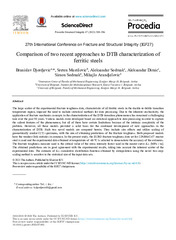| dc.creator | Djordjević, Branislav | |
| dc.creator | Mastilović, Sreten | |
| dc.creator | Sedmak, Aleksandar | |
| dc.creator | Dimic, Aleksandar | |
| dc.creator | Sedmak, Simon | |
| dc.creator | Arandjelovic, Mihajlo | |
| dc.date.accessioned | 2023-08-10T10:26:42Z | |
| dc.date.available | 2023-08-10T10:26:42Z | |
| dc.date.issued | 2023 | |
| dc.identifier.uri | http://rimsi.imsi.bg.ac.rs/handle/123456789/2069 | |
| dc.description.abstract | The large scatter of the experimental fracture toughness data, characteristic of all ferritic steels in the ductile-to-brittle transition
temperature region, imposed the need to include statistical methods for data processing. Due to the inherent stochasticity, the
application of fracture mechanics concepts in the characterization of the DTB transition phenomenon has remained a challenging
task over the past 50 years. Various models were developed based on statistical approach to data processing in order to capture
the salient features of the phenomenon, but all of them have certain limitations because of the intrinsic complexity of the
problem. However, all these models provided a solid basis for the continued development of new approaches in the
characterization of DTB. Such two novel models are compared herein. They include size effects and utilize scaling of
geometrically similar C(T) specimens, with the aim of obtaining predictions of the fracture toughness. Both proposed models
have the weakest link statistics in common. In the present study, the EURO fracture toughness data set for 22NiMoCr37 reactor
steel is used and the experimental data obtained at temperature of -60 ºC is selected to demonstrate the accuracy of the estimates.
The fracture toughness measure used is the critical value of the stress intensity factor used in the master curve KJc [MPa√m].
The obtained predictions are in good agreement with the experimental results, taking into account the inherent scatter of the
experimental data. The estimate of KJc cumulative distribution function obtained by extrapolation using the novel two-stepscaling
method is sensitive to the statistical size of the input data sets. | sr |
| dc.language.iso | en | sr |
| dc.publisher | Elsevier B.V. | sr |
| dc.relation | This research was supported by the Ministry of Education, Science and Technological Development of the Republic of Serbia. | sr |
| dc.rights | openAccess | sr |
| dc.rights.uri | https://creativecommons.org/licenses/by-nc-nd/4.0/ | |
| dc.source | Procedia Structural Integrity | sr |
| dc.subject | Ductile-to-brittle transition | sr |
| dc.subject | Fracture toughness | sr |
| dc.subject | Ferritic steels | sr |
| dc.subject | Statistical processing | sr |
| dc.title | Comparison of two recent approaches to DTB characterization of ferritic steels | sr |
| dc.type | conferenceObject | sr |
| dc.rights.license | BY-NC-ND | sr |
| dc.rights.holder | The Authors | sr |
| dc.citation.epage | 596 | |
| dc.citation.spage | 589 | |
| dc.citation.volume | 47 | |
| dc.identifier.doi | 10.1016/j.prostr.2023.07.065 | |
| dc.identifier.fulltext | http://rimsi.imsi.bg.ac.rs/bitstream/id/5452/1-s2.0-S2452321623004754-main.pdf | |
| dc.type.version | publishedVersion | sr |

